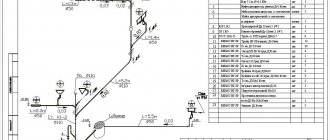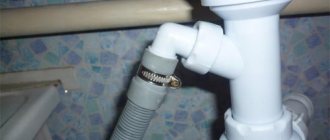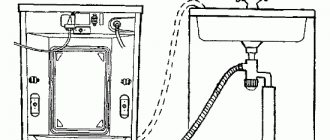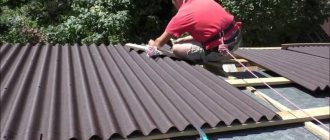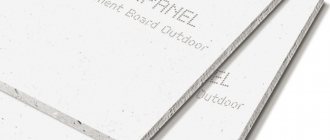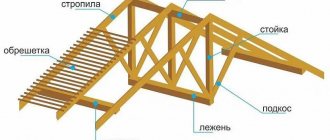Situations when residents of apartment buildings for some reason cannot pay their utility bills are becoming more and more common; in order to encourage them to solve this problem, state housing maintenance services or private management companies are resorting to various methods. One of the latest methods of influence is a sewer plug for debtors, which causes ambiguous opinion in society regarding the legality of its installation.
Since sewer plugs are often placed on citizens based on a bureaucratic approach to their difficult life situations, the network offers a number of ways to independently dismantle or destroy these devices. There are also legal options for solving problems with plugs, and there are precedents when the court decided such cases in favor of the tenant, obliging the management company to pay him compensation.
Rice. 1 Intra-house sewerage diagram
What is a sewer plug for debtors?
According to the government decree of the Russian Federation dated 05/06/2011 354 (last amended on 05/22/2019) on the provision of utility services to users or owners of premises, the management organization (executor) has the right to take measures to suspend or completely disconnect the apartments of defaulters from certain sources of life support. The legislation does not specify specific utilities from which an apartment can be cut off; the ban only applies to turning off heating and cold water. Accordingly, the management organization has the right to stop the supply of electricity, gas, hot water and shut off water drainage.
With the exception of electricity, the distribution panel of which is installed in the common corridor, access to the apartment is required to turn off gas or hot water - this is not always possible if the tenant simply does not open the door. Therefore, the contractors use methods of blocking communications without access to apartments, and the only one of them after a power outage in a common area is installing a plug on the debtors’ sewer system. The plug is installed through the outlet of the sewer riser on the roof without access to the living space; it is lowered on a long cable and automatically closes the sewer outlet from the apartment after the automatic system is triggered.
Rice. 2 Sewer plug for debtors - operating principle and placement for disconnecting the sewerage service
Types of plugs
When installing a plug through a riser on the roof, it is important to determine the location of the debtor’s apartment and bring it to the sewer outlet pipe. To do this, the device is lowered on a cable using a special manipulator, using a video review from the camera to monitor the installation process. Upon reaching a given point, the manipulator activates the plug, while it changes its shape and blocks the inlet to the riser, after which the installation apparatus is removed from the riser pipeline to the surface. All plugs for sewer pipes can be divided into two main types: cylindrical and pneumatic.
Cylindrical
A cylindrical type sewer plug consists of one or more metal plates placed vertically in a partial circle. After lowering into the riser, the manipulator moves the fragments apart, or rather releases the plates from compression; they, due to a spring mechanism, expand and tightly cover any side holes in the riser. The device covers the side walls, and not the channel itself, so there are no problems with other residents higher up the riser.
Some semicircular varieties have teeth on the side edges; due to the elasticity of the material when compressed by a manipulator, they initially have a smaller diameter than the internal size of the riser pipeline. After lowering the riser to a given point, the manipulator releases the plug, it straightens and is held in the pipeline by the end gear plates.
In addition to metal, a cylindrical sewer plug is often made of plastic (polypropylene); its transparent modifications, with a rubber surface or an armored anti-vandal design, are usually used.
One of the varieties of plugs of this type is a device with a mesh on a rigid frame (holes in the plate) instead of a solid valve; its installation is no different from other models, but allows the debtor to use cold and hot water.
The pipe plugs supplied to the market and the corresponding installation devices are represented by a wide range of models; their brands with the names Terminator, Cockroach, Octopus, Grotto, Whale, Onyx have different designs.
Rice. 3 Sewer plug for cylindrical type debtors
It should be noted that the installation of any structures in the riser is essentially a violation of the rules of technical operation of sewer systems; foreign objects can lead to clogging of the passage channel (for example, rags or feminine hygiene items will get caught on the sharp edge of the plug).
Pneumatic
A pneumatic type sewer pipe plug is a durable ball made of plastic materials (rubber) with needle-shaped protrusions on the outer shell. It is loaded into the riser using a manipulator and pushed into the side sewer outlet. After placement, the compressor supplies air to the ball, it increases in volume and closes the side pipe.
This design has one main advantage and disadvantage: the ball does not block the passage channel in the riser, but, unlike a cylindrical design, it is much easier for the debtor to damage and dismantle it.
Rice. 4 Sewer plug for debtors, pneumatic
Regulatory acts
The rules for laying internal sewerage are set out in SNiP 2.04.01-85, some of its points:
In domestic and industrial internal sewerage, inspection or cleaning units are installed:
- On vertical risers without indents - on the first and last floors of buildings.
- If there are indentations - on the floors above them.
- If the number of floors in a building exceeds five floors, an inspection is placed on every third.
- It is placed at the beginning of the outlet pipes if the number of connected plumbing fixtures exceeds three and there are no shaped elements with a hole for cleaning above them.
- At turns in the sewer line, where the movement of wastewater is redirected, and this section is technically impossible to clean through other inspection hatches.
- On horizontal sections of a domestic sewer main with pipe diameters from 100 to 150 mm, the distance between cleaning or inspection elements should not exceed 10 and 15 m, respectively.
Rice. 3 Standards for maximum distances between inspection and cleaning units according to SNiP 2.04.01-85
- If the inspection of the sewer riser is placed on a pipeline laid by a hidden method, a hatch measuring at least 300 by 400 mm must be installed opposite the inspection window.
When laying internal sewer lines, the following standards must be observed:
- for a 50 mm pipeline – a slope of 30 mm per linear meter and a distance from the wall of at least 45 mm;
- for a 110 mm pipeline – a slope of 20 mm per linear meter and a distance to the walls of at least 75 mm;
- the distance from the walls to the shell of the vertical riser is at least 20 mm.
- When the installation is open, the vertical riser is placed in the corner of the room; when it is open, it is placed along the axis of the toilet outlet.
The following distance standards apply for external sewerage:
- Between inspection units there is no more than 8 - 10 m on level ground and 5 - 6 m on hills.
- The inspection well should be located no further than 12 m from the outlet with a pipeline diameter of 100 mm.
- If gray water is transported, the distance between the well and the outlet can be increased to 20 m.
Article on the topic:
Slope of sewer pipe - installation standards and features . It may be interesting to read an extended article about the norms for slopes of sewer pipes for internal and external sewers!
Rice. 4 Polymer revisions at 110 and 50 mm
Sewer plugs for debtors - is their installation legal?
To answer the question of whether a management organization is authorized to install a sewer plug for debtors for non-payment, one should consider the fundamental document, which is Government Decree of the Russian Federation No. 354. The main provisions for the actions of public utilities in relation to debtors are indicated in paragraph XI, paragraphs 114 - 119, their contents are as follows:
1. In case of utility debts from residents, the contractor is obliged to seal electrical panels, plumbing fixtures and other equipment both inside and outside the apartment of the debtor consumer.
2. Regardless of the presence or absence of an agreement with the resource supplying organization from whose networks the debtor is cut off, disconnection operations are carried out by an organization engaged in the maintenance of utilities at home.
3. To carry out the work, a court decision is not required; the basis is an application from the organization supplying the resource or providing services.
4. If the rent is not paid in full, the contractor is obliged to knowingly notify the defaulter before limiting or stopping the provision of services. By incomplete payment we mean an amount higher than 2 months’ payment for one utility service.
5. In case of partial payment of rent, the entire amount is divided between services and expenses for technical operation, deductions for major repairs in proportion to their size. It should be noted that this clause excludes the legal loophole that the debtor could take advantage of by paying the minimum amount of rent with a statement that he only pays sewerage services with the expectation that a plug will not be installed.
Rice. 5 Mesh plug for sewerage for debtors
Make it yourself or buy it
Independent production of locking devices requires professional skills and a set of special equipment. The sewer system is subject to increased requirements in terms of reliability and tightness.
In the retail chain you can purchase ready-made plugs or parts for their manufacture. It is advisable to take on such work yourself only in cases where the necessary products are not available for sale or their cost is excessively high.
We put a plug on the sewer - what to do?
Consumers who find themselves in a situation with a blocked sewer outlet have several ways to solve the problem; they can be roughly divided into legal and illegal. The measures taken by the consumer debtor consist of the following actions:
- Full payment of the rent debt, in this case the contractor must remove the plug within 2 days.
- Usually, a person who finds himself in a difficult life situation can always come to an agreement with the management organization in the form of a written agreement with the executor on debt restructuring. In this case, an agreement is concluded between the parties with phased monthly payment of the resulting debt, although for the last month the rent will have to be paid in full.
- Since, in the opinion of many human rights activists, this method of dealing with defaulters is a humiliation of human dignity and even equates to torture, if the consumer-debtor has valid reasons for not paying rent on time, you can file a claim with the European Court of Human Rights ECHR after going through all legal proceedings authorities of the Russian Federation.
It is clear that citizens with such capabilities are unlikely to find themselves in the situation of rent debtors, because filing a claim will require the services of expensive lawyers. In addition, the cost of the issue is not too high and the application is likely to be rejected for consideration.
- The reason for appealing to the Russian courts may be a violation of user rights when installing a blind sewer plug. Since, according to the law, the contractor does not have the right to turn off cold water to debtors, and the use of a plug actually leads to its shutoff due to the impossibility of draining, there is some probability of obtaining a decision in the courts to cancel the installation. It is clear that suing the state housing maintenance service from the same branch with the court is problematic, however, if the management company is a private structure, the chances of winning the case increase.
- Another legal clue for appealing to the courts is blocking the sewer system for a defaulter in a communal apartment with several owners who do not have rent arrears. A similar situation is if tenants live in the same apartment with separate settlement accounts for rent and one of the parties has no utility debts.
- You can turn to “black” plumbers who have equipment for installing and removing plugs, but this will require free access to the roof through a closed technical floor, and the cost of the service can be quite significant.
- If a consumer-debtor has been given a plug, he has already received money in the amount of about 10,000 rubles, which will be forcibly deducted from him for installing and dismantling the device. There is no doubt that this amount also includes the price of the plug itself, the cost of which is not too high and it cannot always be reused.
Therefore, the debtor consumer can independently try to remove the plug with virtually no consequences, while at the same time providing a good service to the company - its specialists will not have to go to the site and waste time dismantling it.
Rice. 7 Sewer plug for debtors. installed on the toilet
Chemical method
The basic principle is to use alkaline components.
You can pour the drug “Mole” into the sewer yourself; it is often used to remove blockages. After reacting with water, the mixture will begin to boil and the sewer plug will gradually dissolve. It must be said that this method can only work if the plug is metal, since the rubber ball does not corrode. In addition, it will take at least a week for “Mole” to dissolve the metal.
The procedure for installing and removing a sewer plug
Almost all multi-storey buildings have a central riser that runs through all floors and ends in a vent pipe on the roof, which is necessary for ventilation and air access to the duct. Therefore, theoretically and practically, installing a plug through a pipeline from the roof to any apartment does not present any particular difficulties; operations are carried out in the following sequence:
- Using a special camera and lighting, the condition of the sewer riser (the surface of the inner shells of the pipes) in the overlap area is studied, and based on this, the type of plug is determined. At the same time, the material of manufacture of the riser is also taken into account - different types of plugs are installed on smooth polyvinyl chloride (PVC) plastic and cast iron pipes rough on the inside.
- Next, they begin to immerse the plug, models with sharp teeth are lowered into a PVC plastic pipe for fixation on smooth walls, and self-expanding structures are placed in cast iron risers.
- After the user pays the rent in full, representatives of the installation company return to the roof and lower the manipulator into the sewer shaft. An operator-controlled device compresses the sliding structure or releases air from the ball, after which it removes the plug to the surface.
Rice. 8 Cylindrical sewer plug for debtors placed in the sewer tee
Nuances of choosing a check valve
Before purchasing a shut-off device for personal use, you should carefully analyze the features of your sewer system. Based on its specifics, you have to choose.
When choosing the best option, you should pay attention to the following characteristics:
- diameter of sockets;
- material;
- fixture size;
- installation complexity;
- quality and guarantee;
- price.
Moreover, price is clearly in last place - the reliability and functionality of the valve do not depend on it. Here you should focus on your financial capabilities. For example, there is no point in buying a sophisticated model of a locking device with an electric motor for more than 120 thousand for a modest dacha with cheap plastic sewer pipes.
For the installation of sewer systems, models of check valves with horizontal and vertical installation methods are produced. Horizontal ones are mounted on main lines, vertical ones on risers
The most important parameter is the diameter of the sockets. This is the key characteristic and must match the diameter of the sewer pipe into which the check valve is to be installed.
Taking a smaller or larger cross-section of the device and buying special adapters would be the wrong decision. This will disrupt the smooth functioning of the system and may disrupt the throughput of installed pipes.
The material from which check valves are made is the same as the material of sewer pipes:
- plastic;
- steel, including stainless steel;
- cast iron;
- bronze;
- other materials, less common.
From the available options, it is best to choose the same one as the installed sewer pipes in a house, cottage, or apartment. It is not advisable to embed a plastic valve into a cast iron pipeline and vice versa. Moreover, plastic models are the most affordable.
Models of shut-off devices made of metal must be correctly installed in the same pipeline made of similar material
As for the size, the locking device should be selected based on the availability of space for its installation. Do not forget that there are valves for vertical and horizontal installation.
Most often the second option is chosen. But if there is not enough free space in the bathroom, kitchen, behind the toilet or in the utility room, take the vertical option.
If there is very little space, then a reasonable solution would be to use wafer check valve models, for installation of which only seals are required
The cost of installation work depends on the ease of installation if you plan to invite a plumber. If this is a simple plastic model, then a home craftsman with a minimum set of tools can install it.
Also, before purchasing, it would be a good idea to look at the model you like and check it so that nothing dangles or creaks under your fingers. You need to pay attention that there is an arrow on top, marked by the manufacturer.
Each high-quality product must indicate the direction of movement of sewage, which eliminates errors during installation.
You need to ask the seller for a manufacturer's warranty for this product. A high-quality product produced at the factory always has warranty documents and installation recommendations.
In private homes and cottages, the shut-off valve can also perform the function of protecting against rodents
How to remove a plug in a sewer and can you do it yourself?
Considering that the consumer-debtor has the right to legally not allow employees of the management organization into his apartment, it is problematic to prove the fact that the plug was removed. The tenant can always claim that he knows nothing about its fate and suggest that it was poorly installed and fell into the riser shaft itself.
There are different methods of how to remove a plug from a sewer yourself, depending on its specific design, the material of manufacture of the riser pipeline, the main ones are:
Universal . Since the damper is located at the outlet of the riser pipe, to which the toilet is connected through a corrugation, the easiest way is to remove the plug from the sewer by dismantling the plumbing fixture. To do this, unscrew the two screws securing the toilet to the floor, close the valve and disconnect the flexible cold water supply from it, after which the device is removed from the toilet room. Next, remove the corrugation and observe the plug itself in the short outlet pipe of the riser.
If a pneumatic model in the form of an inflatable ball is installed, it is pierced with a sharp object and removed by hand. If a cylindrical damper is placed in a riser channel, it is destroyed physically - the metal (polymer) plates are damaged with a steel crowbar or a nail puller, a hole is drilled around the perimeter of the pipe with a long drill using a drill, after which the passage is cleared or the plug falls into the sewer. If there is a mesh, you can cut it with metal scissors or expand the cells with a crowbar for better drainage passage.
Rules for using the device
In order for the non-return valve to protect the house/apartment from the reverse flow of sewer water for a long time, it must be serviced in a timely manner. Therefore, it is important to provide convenient access to it.
Every 6-12 months you will need to open/unscrew the inspection cover and, if necessary, remove debris accumulating on the valve
It is possible that during the process of removing used water, noise, creaking and other unpleasant sounds occur. In this case, it is necessary to check the shut-off valve ahead of time - breakdowns in the form of worn parts or unexpected clogging are possible.
If you do not check everything in time, then when the sewage flows back, the device will not be able to fulfill its purpose and dirty water will begin to come out of all plumbing fixtures.
It is advisable to install check valves on each plumbing fixture so that if one of them breaks down, the rest will work
In the case when an automatic device with an electric motor is used, you must strictly adhere to the recommendations for its maintenance and change spare parts in a timely manner. The wear periods of individual elements of the device are indicated by the manufacturer in the instructions.
It is important to follow the recommendations and maintenance schedules for shut-off devices with an electric motor to ensure maximum protection of your home/apartment from flooding
It happens that during the audit, wear of certain parts was discovered, which cannot be replaced - the manufacturer does not produce the necessary spare parts.
In simple models with valves, if the locking part fails, it is better to buy and install a new valve to replace the damaged one
You should not repair a damaged part with improvised materials - there is no guarantee that, if necessary, a homemade damper will cope with the pressure of wastewater from the pipeline in the opposite direction.
Useful tips
If a management organization practices installing sewer plugs in the apartments of debtor users, one of the useful tips is to prevent such a situation. In addition to the significant inconvenience of living without a sewer system, the amount of debt for utilities will increase even more due to the cost of installing a shutter device.
If you choose the lesser of two evils, it is better to allow the contractor’s workers into the apartment and allow them to put a plug on the hot water; without it you can live much more comfortably than without sewerage.
An almost win-win option is to drill a through hole in the riser pipe in advance and screw a bolt or insert a pin into it - then they won’t be able to lower the plug and install it on top, you won’t have to pay money for its installation, and you won’t have to let anyone into the apartment.
The only problem that may arise for residents of the lower floors is the possibility of installing a plug from below using rods; in this case, you will have to drill the pipe and install a pin (screw in a bolt) at the level of the inlet sewer pipe into the riser and the plug will not be able to be installed on either side.
In order not to drill into the riser pipes, you can remove the toilet bowl with the corrugation and insert a sufficiently long piece of reinforcement in the middle of the outlet sewer pipe with an emphasis on the rear wall of the riser so that it does not fall down - in this case, the drain hole cannot be blocked either from below or from above .
How to use the toilet if you put a stopper for debts
The toilet can be used if the drainage service is partially interrupted, when a coarse mesh is installed instead of a blind plug. Theoretically, feces can be washed away with large amounts of hot water, in which they gradually dissolve by pushing them down the drain with a plunger. Once a blind modification has been installed, and various methods of removing the plugs have not been used or have not brought a positive result, there can be no talk of using the toilet and sewerage system.
The debtor user can negotiate with neighbors, visit bathrooms at work, in the building of housing and communal services or management company, at public catering establishments (McDonald's), in places of cultural recreation (cinemas, theaters, cafes, bars), dry toilets on the streets or construction sites, paid establishments. In emergency situations, green spaces or high snowdrifts in winter, located near the debtor’s place of residence, can help out.
Rice. 12 How to remove and install a sewer plug for debtors using manipulators
Installing a sewer plug for debtors is a rather extreme measure of influence on the debtor, incomparable in the nature of the inconvenience introduced with a shutdown of electricity, hot water, gas, and besides, the consumer-debtor will have to pay a considerable amount for its installation and dismantling. Although in practice, in order to clear the sewer, any plug can be removed or damaged, it is better to avoid rent arrears, and if such a situation arises, agree with the management of the performing company on the gradual monthly payment of part of the debt according to a jointly drawn up schedule.
Features of use
The operation of the audit is sporadic. There are many elements that have never been used during their entire service life, so home craftsmen have no experience working with such devices. There are no fundamental requirements for the use of revisions, the only condition is accuracy and attention - it is easy to damage the edges of the outlet with a cable, which will break the tightness of the connection between the cover and the pipe. This can cause a bad odor and leaks, which will require labor-intensive replacement of the entire element. During cleaning, you should take into account the danger and act as carefully as possible, then the result of the work will be fully expected and favorable.


